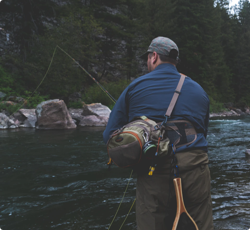
Outdoor Report 9/7
The chinook retention below Tongue Point, on the Columbia, ended with a bang this week. The reports from our Prostaff were, most of the morning was fast paced with chinook bites, and after they caught their limits of chinook they switched over to targeting coho. Some folks would stumble into a pile of coho and others would struggle to find that batch of fish that would push in each tide set. Those that had the best success were fishing a mixture of bait and spinners, with bait being the most popular option. As more and more coho show up you will see spinners play a big role in folk’s success. Even though chinook retention below Tongue Point is currently closed, that doesn't mean that it's not worth going down for coho. The first few weeks of September can be some of the most phenomenal days of coho fishing that the Columbia has to offer. Spinners and bait all have their spot in your arsenal when it comes to catching these little chrome fish. Try targeting the schools of coho a little higher in the water column; a lot of folks will stagger their rods anywhere from 20-35 feet on the line counters. If you’re not seeing action, then try and move to find them. When there are coho around, multiple people will typically be hooking up. Chinook retention is still open above Tongue Point and the first few weeks of September are typically some of the most productive. On the outgoing tide people are typically fishing wobblers on anchor. Over the years, this has been one of the most widely used techniques when targeting these fall chinook. All types of wobblers will work, with Simon, Alvin, Brad’s and Clancy's being among the top producers. If you’re unable to capitalize on the outgoing tide, don't worry. The last few years the 360° flasher craze has really changed the way a lot of people fish, especially on incoming tides. People will fish these flashers with small 3.5 spinners, Brad’s Super Baits, anchovies or herring. Again, people will typically be fishing these suspended in the water column. Most folks will have their line counters set anywhere between 30-45 feet. As you head up closer to Bonneville Dam a lot of folks switch their wobblers out for Kwikfish. The water tends to run a lot harder up near the dam and Kwikfish will be a much better option. Also, folks are starting to run the 360° flashers up there as well. Finding softer current seams will be imperative when using these flashers. Tributary coho fishing will be starting up any day now. These fish can be caught a number of ways. Such as casting spinners, plugs or spoons, bobber fishing eggs, Brad’s or jigs, and one of the newest trends is to catch them on twitching jigs. Swing by any of our three locations, the tackle staff will be more than happy to assist in getting you dialed in for these scrappy little chrome rockets. As water temperatures begin to cool, look for smallmouth bass fishing to improve in the Willamette and Columbia Rivers, as fish begin to feel the urgency to pig-out prior to the long winter ahead. Crankbaits, spinner baits and plastics will all catch fish this time of year, and larger baits like the Keitech Swimbait will start to perform again. After a summer of active feeding, some of the biggest bass of the year are caught in the fall. Catch and release sturgeon is also a great option this time of year. It is always a great fishery to get younger anglers into the outdoors; with consistent action and the ability to set the hook themselves. Last weekend marked the opening of Dove and Forest Grouse (Blue and Ruffed) seasons in Oregon and Washington. September Goose season opens on Saturday 9/9 in most areas of the two states. Before heading out make sure to check local regulations. Good luck and be safe!





